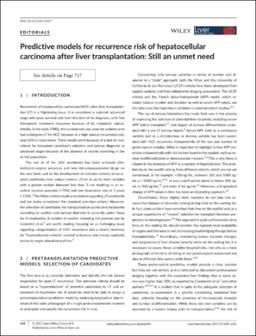| dc.description.abstract | Recurrence of hepatocellular carcinoma (HCC) after liver transplanta-tion (LT) is a frightening issue. It is considered a systemic advanced stage with poor survival rate from the time of its diagnosis, with few therapeutic treatment resources because of its metastatic nature. Initially, in the early 1980s, the survival rate was poor for patients who had undergone LT for HCC because of a high tumour recurrence rate, near 65% in most series. These results were because of a lack of clear criteria for transplant candidate’s selection and tumour diagnosis at advanced stages because of the absence of routine screening in the at- risk population.The rise of LT for HCC worldwide has been achieved after technical- surgical advances and new immunosuppressive drugs on the one hand, and to the development of selection criteria of trans-plant candidates (one unique tumour ≤5 cm or up to three nodules with a greater nodule diameter less than 3 cm) resulting in an ex-cellent survival outcome (>70%) and low recurrence rate at 5 years (<15%).1 The Milan criteria made a revolution regarding LT worldwide and are today considered the standard selection criteria. However, the selection of candidates for transplantation purely and exclusively according to number and tumour diameter is currently under focus for re- evaluation. A number of studies, including the present one by Costentin et al.2 are worth reading focusing on a challenging issue regarding categorization of HCC recurrence and a recent tendency for “hyperselection criteria”, created to balance and ensure equitable access to organ allocation policies.3 | en_US |


